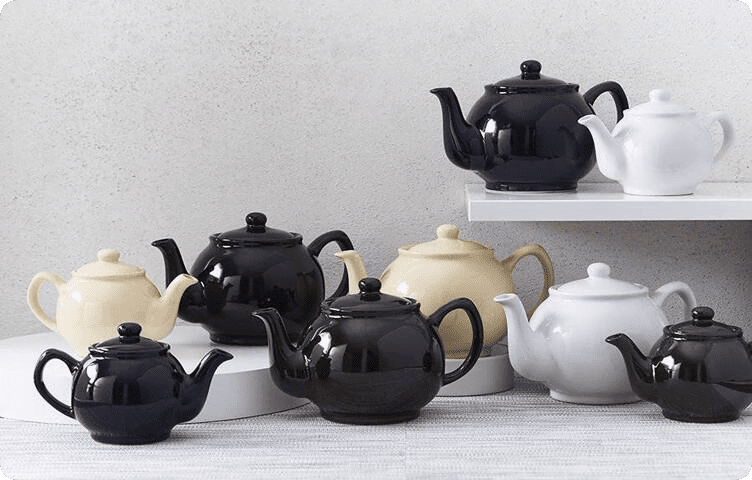Restaurant etiquette requires serving tea to guests no later than 30 minutes after brewing. Therefore, a hot drink is brought to the table directly in a teapot . Dishes not only affect the taste and aroma of the product, but also help create the atmosphere of traditional tea drinking.
Tea in restaurants and how it is served

An aromatic drink made from tea leaves is the leader in popularity in catering establishments. It is brought to guests a few minutes after the order is accepted. The temperature of the liquid should not be lower than +75° C. Therefore, tea is served fresh, in the same container in which it was brewed.
Serving for tea includes cups , which are placed on saucers with the handle to the right. Place a teaspoon nearby. Baking rusks are placed along the table, sugar bowls and milk jugs are in the center. Jam and honey are served in separate rosettes for each guest.
The teapot is placed to the right of the guest's cup. For a shared order, one large pot of tea is served for all customers sitting at the table. It is placed in the center, next to the milk jug and sugar bowl. If the restaurant concept requires brewing in front of visitors, transparent glassware is used.
The waiter pours tea on the right side of the client. Self-service prevails in the cafe, in which guests fill the cups themselves.
Types of teapots

The type of teaware depends on the type of drink served. Four models are used for loose leaf and herbal teas:
classic - a product of spherical or oblong shape, with a spout, lid and handle;
with a flask - a dish equipped with a filter compartment inside into which the tea leaves are poured;
gongfu - a tall Chinese teapot of large volume;
French press - a device with a glass container and a piston that allows you to filter the drink, separating the leaves from the liquid.
For white and yellow tea, teapots of increased volume, cylindrical or tetrahedral, are used. Oolong and hibiscus are prepared in massive low dishes with thick walls.
Features when choosing
The richness of taste and the development of aroma are directly related to the material from which the brewing utensil is made. Clay products are most suitable for green, yellow, and white teas. Choose teapots with traditional Chinese designs for these varieties. Make sure that there is no glaze on the inside, as this coating often disguises low quality.
If black and Japanese tea is in great demand in your establishment, buy earthenware or porcelain teapots . They do not absorb odors like clay and are considered universal utensils for any hot drinks. If you have fruit or flower tea in your assortment, we can recommend glass teapots ; serving them in them is very impressive.
In the catalog of our online store you can find ceramics and glass products made in various styles - from Russian classics to Japanese minimalism. Volume plays an important role when choosing cookware. The optimal capacity for utensils designed for one guest is from 110 to 200 ml. Large m holds from 700 ml to 2 liters.
Also consider the weight and shape of the product. Heavy teapots with fancy decor are inconvenient to use. Choose utensils with a stable bottom, a wide handle and a tight-fitting lid.
Rules of care
The main “enemy” of brewing utensils is tea plaque. Accumulating inside, it worsens the aroma of the drink and gives it a musty taste. To avoid this problem, the kettle should be washed immediately after use.
Avoid any detergent as it may remain inside the spout. Use only clean, hot water and a microfiber cloth. For severe contamination, use baking soda. At the end of washing, rinse the inside of the kettle with boiling water and leave until completely dry.
















































/https%3A%2F%2Fcomplexbar.com%2Fimages%2Fblog%2F200%2Fchajnik-dlya-restor.jpg)
/https%3A%2F%2Fcomplexbar.com%2Fimages%2Fblog%2F245%2Fskov_glavn.jpeg)
/https%3A%2F%2Fcomplexbar.com%2Fimages%2Fblog%2F245%2Fhaiboli.jpg)
/https%3A%2F%2Fcomplexbar.com%2Fimages%2Fblog%2F245%2Fvilki-na-stole-752x480.jpeg)
/https%3A%2F%2Fcomplexbar.com%2Fimages%2Fblog%2F246%2F2024-04-09_17.22.54.jpg)
/https%3A%2F%2Fcomplexbar.com%2Fimages%2Fblog%2F246%2F2024-04-09_17.22.47.jpg)
/https%3A%2F%2Fcomplexbar.com%2Fimages%2Fblog%2F246%2FCODE_anons_foamydrops_752%D1%85480_eng.jpg)
/https%3A%2F%2Fcomplexbar.com%2Fimages%2Fblog%2F246%2FAlina_752%D1%85480_eng.jpg)
/https%3A%2F%2Fcomplexbar.com%2Fimages%2Fblog%2F246%2F2024-04-09_17.23.22.jpg)
/https%3A%2F%2Fcomplexbar.com%2Fimages%2Fblog%2F246%2F2024-04-09_17.23.28.jpg)
/https%3A%2F%2Fcomplexbar.com%2Fimages%2Fblog%2F246%2F2024-04-09_17.23.35.jpg)
/https%3A%2F%2Fcomplexbar.com%2Fimages%2Fblog%2F246%2Fdrinksome_752%D1%85480_eng.jpg)
/https%3A%2F%2Fcomplexbar.com%2Fimages%2Fblog%2F246%2Fnude_752%D1%85480_eng.jpg)
/https%3A%2F%2Fcomplexbar.com%2Fimages%2Fblog%2F246%2F752%D1%85480_eng__1_.jpg)
/https%3A%2F%2Fcomplexbar.com%2Fimages%2Fblog%2F246%2F752%D1%85480_eng.jpg)
/https%3A%2F%2Fcomplexbar.com%2Fimages%2Fblog%2F246%2FStudioRaw_752%D1%85480_eng.jpg)
/https%3A%2F%2Fcomplexbar.com%2Fimages%2Fblog%2F246%2FDoppio_tea_752%D1%85480_eng.jpg)
/https%3A%2F%2Fcomplexbar.com%2Fimages%2Fblog%2F246%2FTognana_Stars_Stripes_752%D1%85480_eng.jpg)
/https%3A%2F%2Fcomplexbar.com%2Fimages%2Fblog%2F246%2FRona_752%D1%85480_eng.jpg)
/https%3A%2F%2Fcomplexbar.com%2Fimages%2Fblog%2F246%2FDoppio_vending_752%D1%85480_eng.jpg)
/https%3A%2F%2Fcomplexbar.com%2Fimages%2Fblog%2F246%2FEssence_sukhie_smesi_752%D1%85480_eng.jpg)
/https%3A%2F%2Fcomplexbar.com%2Fimages%2Fblog%2F246%2FODK_sukhie_smesi752%D1%85480_eng.jpg)
/https%3A%2F%2Fcomplexbar.com%2Fimages%2Fblog%2F246%2Funiforma-barmena.jpg)
/https%3A%2F%2Fcomplexbar.com%2Fimages%2Fblog%2F246%2Fkak-nanyat-barmena.jpg)
/https%3A%2F%2Fcomplexbar.com%2Fimages%2Fblog%2F246%2Fsirop_scale_2400.jpeg)
/https%3A%2F%2Fcomplexbar.com%2Fimages%2Fblog%2F246%2FPeugeot_Anons_Paris_U%27Select_Line_Daman_752%D1%85480_eng.jpg)
/https%3A%2F%2Fcomplexbar.com%2Fimages%2Fblog%2F246%2Fkofe-vostochniy.jpg)
/https%3A%2F%2Fcomplexbar.com%2Fimages%2Fblog%2F246%2FMadler.jpg)
/https%3A%2F%2Fcomplexbar.com%2Fimages%2Fblog%2F246%2Fprofbartender_glavn.jpeg)